After the Knechtles left Canada to go back home to Trinidad, we hired a car for a week to explore Cape Breton.
One of the things we planned to do during our time with the car, was visit the “Highland Village museum”. We had no idea quite what to expect, (how long it would take, what it involved, etc.), but my Dad decided to book us for the ‘story time’ tour they offered at 2:30 in the afternoon.
We set out earlier than that, as we tend to want to see everything in DEPTH and it seems as though there is an unspoken law in Cape Breton that all the attractions are stationed 30 to 45 minutes’ drive away from Baddeck. Of course it is due to the unpopulated nature of the place, but it does get rather tiring when it takes your whole day to see one thing.
One mini-adventure on our way over happened when we had to cross a little finger of lake by ferry boat. It is attached to both shores with a cable. The cable is attached to the motor which pulls the ferry from one bank to the other and back again. It also provides a lot of stability to the ramp while cars are boarding and driving off.
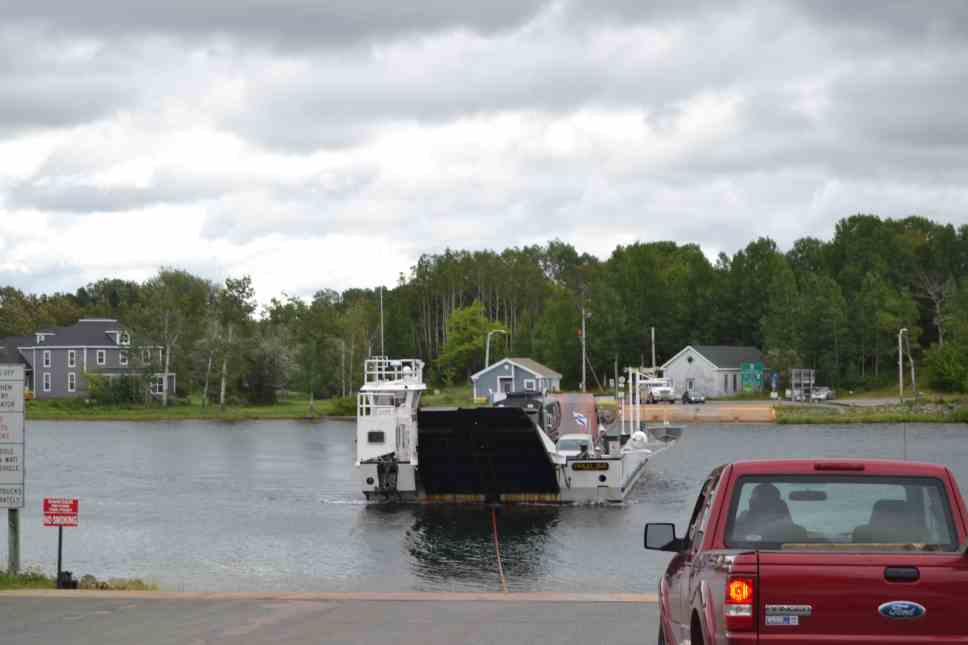 When we arrived, they told us that the Highland village experience is way better during the story time tour. (I.e., don’t go before then.) So we decided to go and look for some nearby geocaches while waiting for the tour to start.
When we arrived, they told us that the Highland village experience is way better during the story time tour. (I.e., don’t go before then.) So we decided to go and look for some nearby geocaches while waiting for the tour to start.
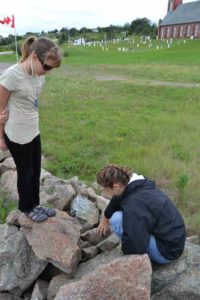 I really like geocaching. My Dad views it as a ‘do it if it doesn’t interfere with immediate plans’ kind of activity or a way to get us to go for a walk. I don’t think my sisters really do it just for the fun of finding the geocache. They’re more into it for other reasons. (For example, Franci likes bird watching, and going geocaching is an opportunity to walk around and see birds.)
I really like geocaching. My Dad views it as a ‘do it if it doesn’t interfere with immediate plans’ kind of activity or a way to get us to go for a walk. I don’t think my sisters really do it just for the fun of finding the geocache. They’re more into it for other reasons. (For example, Franci likes bird watching, and going geocaching is an opportunity to walk around and see birds.)
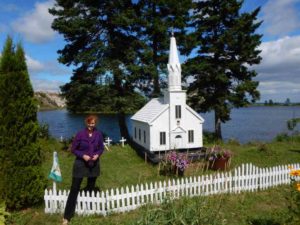 After finding three geocaches and a cute little scale model of a church, we headed back up the hill and met our tour guide.
After finding three geocaches and a cute little scale model of a church, we headed back up the hill and met our tour guide.
After introductions we followed him on foot, to the top of the hill where he outlined the history of the Nova Scotia highlanders.
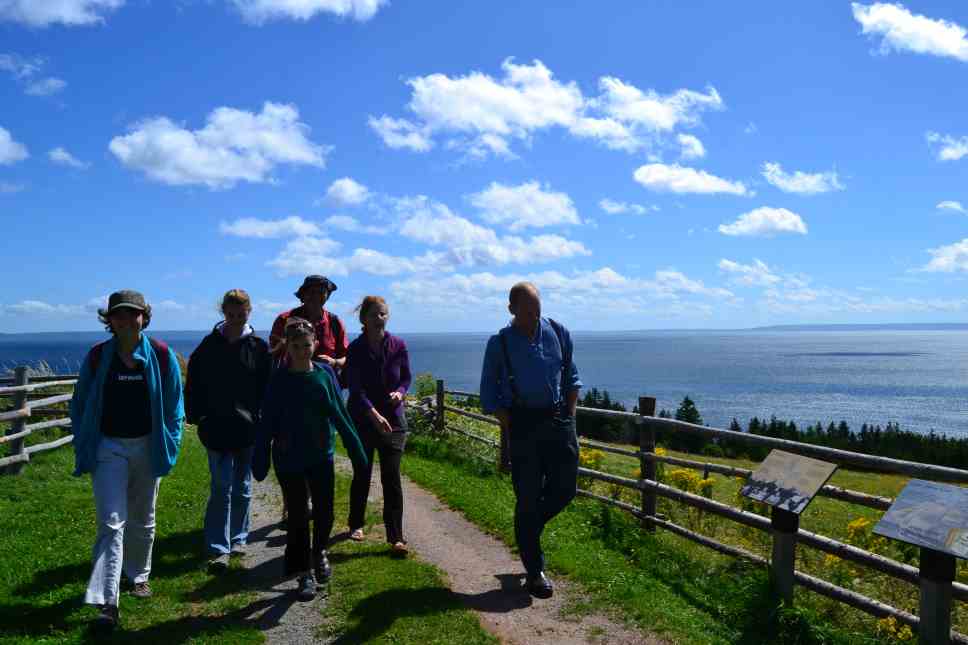 A brief summary would be that the Scots (Gaelic Scots for the most part, as far as I can remember), had immigrated to Nova Scotia. They all immigrated at different times and for different reasons. (Some to look for adventure, others for religious freedom, etc.)
A brief summary would be that the Scots (Gaelic Scots for the most part, as far as I can remember), had immigrated to Nova Scotia. They all immigrated at different times and for different reasons. (Some to look for adventure, others for religious freedom, etc.)
The people we learned about specifically were the Highlanders. This group of Scots had not been permitted to speak their own language (Gaelic), wear their traditional dress or play the bagpipes. This all happened after some big battle in Scotland. The long used Clan custom where a chief owned the land and apportioned it to be worked was suddenly thrown out of balance when the chiefs were promoted to lords, and it all went downhill from there. The plain fact was that the Highlanders were oppressed, and whenever they could, they left Scotland.
Our tour followed a series of houses. Each of these are built in a certain style that relates to a different time period. Inside of each home, we found one or two people that seemed to belong there.
The first house we visited was a little sod house. From the door of the house you could see far out over the lake. They sky was really clear and blue that day, and the air wonderfully fresh. That’s something I really liked about Nova Scotia – everything seemed fresh! Little flowers in the grass, clear sky, cool wind. Tropics tend to be lacking in the “cool breeze” department.
The sod hut itself was fairly small, with grass growing on the roof. It had two doors, for the sake of the tourists. Real sod houses had only one door and a little one at that! It also had just one small window and a hole you could open in the roof.
Our “Story Time” visit meant that whenever we entered a dwelling, the guide would greet the residents in Gaelic. Then, after exchanging a few words, they would switch over into English. They told of the brother (imaginary) who had just gone out to fetch the sheep, the father who had decided to follow cousin Furges’ example and immigrate to Nova Scotia. They apologised for the lack of fire in the house, explaining how the landlord had come and put it out. (A bad omen.) They told of how they had to do things to keep the fairies from stealing the baby. The younger of the two women was sitting on a low stool in the gloom of the fireless house, using some kind of wooden block to hand-spin wool while she talked.
They told us how all the animals would sleep with them in the house, and how they had to keep the fairies happy with some oatcakes, among other things. A very superstitious people.
After we had exhausted the stock of questions we could think of at the time, we moved on to the next house. All the houses were arrayed on the top of the hill – mostly wooden structures. The sod hut being the only exception. A few other buildings such as the barn, the church, the smithy and the store were also stationed amongst these houses.
The next house was a house that would have been built by people living in Nova Scotia at a later time. It had quite a few people in it and what we mostly did there was sit in a room, having a ‘Ceilidh’. (Pronounced ‘Kay-lee.’)
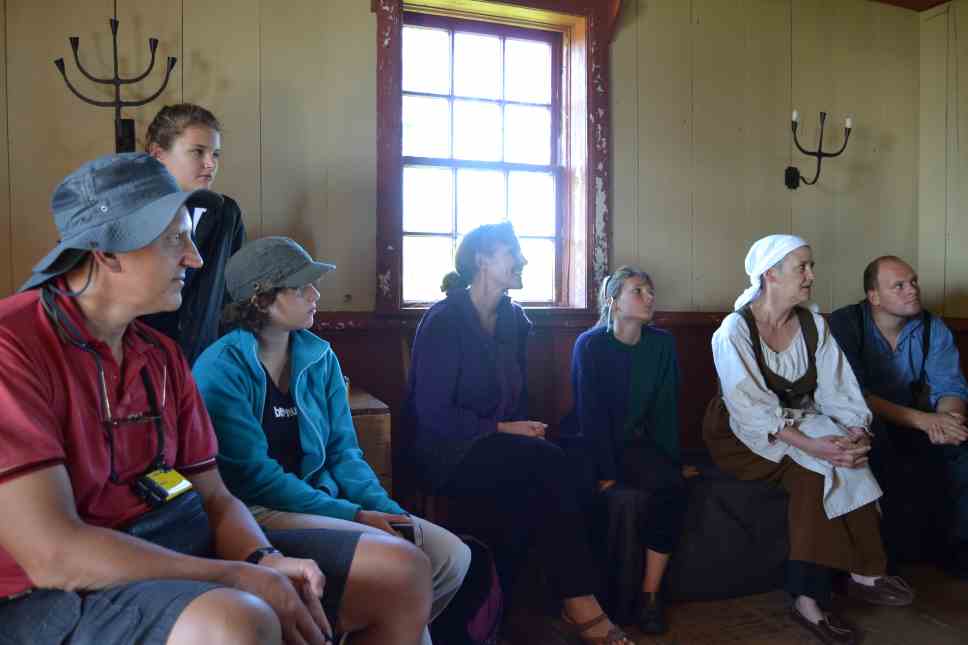 They sang songs in Gaelic, explaining the meaning to us and also played some fiddle music. They told us some things about the people who live in Nova Scotia today and still speak Gaelic. In this house there were also examples of dyed wool and two types of spinning wheels.
They sang songs in Gaelic, explaining the meaning to us and also played some fiddle music. They told us some things about the people who live in Nova Scotia today and still speak Gaelic. In this house there were also examples of dyed wool and two types of spinning wheels.
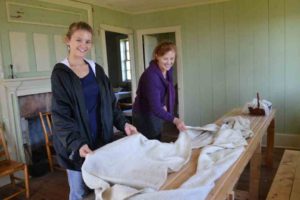 On the table in the room next door we found a woven piece of wool cloth on the table. (Tell you more about that later.)
On the table in the room next door we found a woven piece of wool cloth on the table. (Tell you more about that later.)
After that we were taken into the church, which our guide told us had been brought up from across the valley in one piece! Somehow they had lifted the whole wooden structure with a crane and had carted it all the way up the hill! It is quite a big church, so I suppose they just had big cranes.
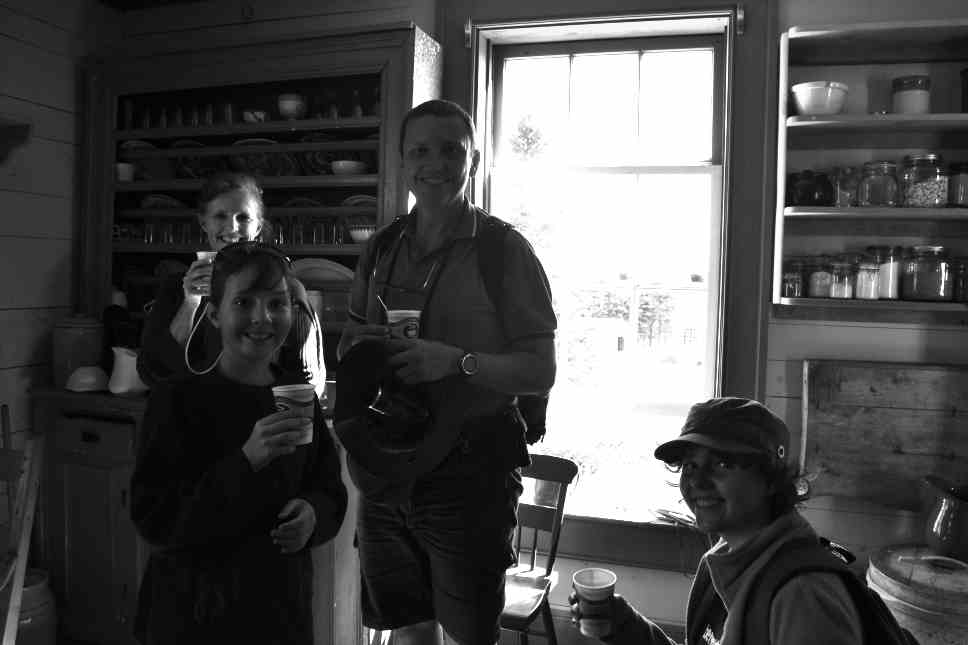 The next house involved tea and oatcakes. (They call them oatcakes, but to me they are cookies 😉 ) We thoroughly enjoyed them, that’s for sure!
The next house involved tea and oatcakes. (They call them oatcakes, but to me they are cookies 😉 ) We thoroughly enjoyed them, that’s for sure!
The times had moved on – our pleasantly plump hostess, who poured the tea with a smile – wore a dress made from printed fabric. The house boasted two wood stoves; one in the kitchen (it had kept our tea nice and hot while we were exploring the previous houses) and another in the sitting room. Neat black stoves with pipes running up into the roof. The one in the kitchen was bigger than the parlour version because it was used for cooking as well as heating the room.
–
–
Our hostess was also kind enough to climb into the loom standing in the next room, so that she could demonstrate how it works. For the first time I understood it properly! I’m sorry to say you’ll have to look up on youtube if you want to know how it works – it’s too complicated for me to try and explain it without some visual aid . . .
–
Our next stop was the “store”. Filled with everything you could not make for yourself in that time, it looks like an antique shop. ;P Old buttons behind glass, kegs of nails, hats on hat-stands and a big cash register on the counter that looks very imposing and important with all the brass working on its sides.
–
–
We briefly visited the smithy before going into our last house.
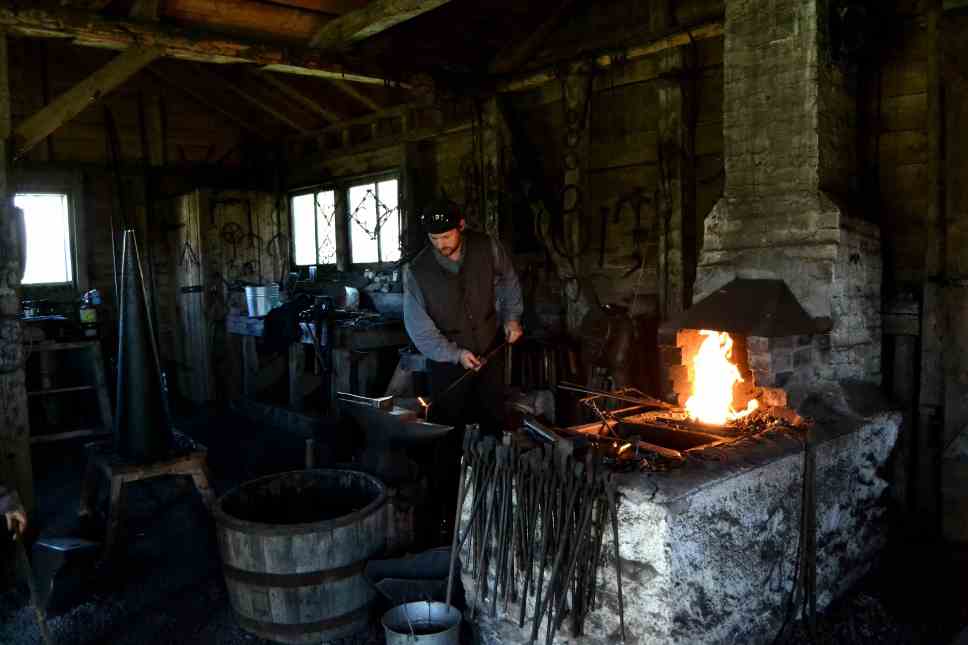 The last house had quite a lot of things going on in terms of furniture and gimmicks. Every room had it’s own wallpaper print! They told us something of the wakes people used to have when someone died. It would last for three whole days! They also told us how busy the house would be during that time.
The last house had quite a lot of things going on in terms of furniture and gimmicks. Every room had it’s own wallpaper print! They told us something of the wakes people used to have when someone died. It would last for three whole days! They also told us how busy the house would be during that time.
That house has a lot of modern conveniences. Since Alexander Graham Bell lived in Nova Scotia part time, it was one of the first places to get the telephone. This house has a big switchboard in a corner, and an old telephone on the wall. There is a “washing machine” in the kitchen, or what amounted to one in that time and all sorts of little gadgets to use for various tasks. (For example, a 2-D wire sock, so that the socks won’t shrink while they dry.)
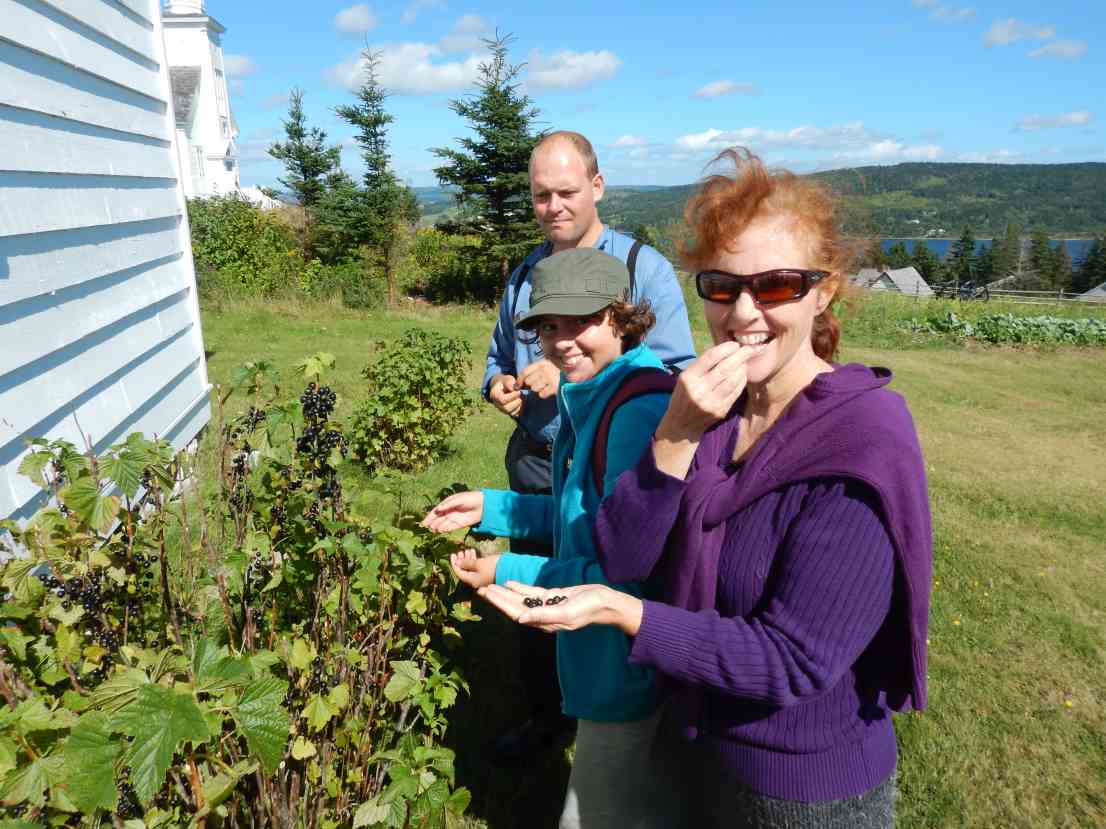
Eating some berries that grows next to the houses during summer. (Those specific berries were some kind of current berry. I didn’t really like them.)
We wrapped up our visit to this delightful “village” in a barn-like building where a big black machine stands looming in the background. There are some benches in front of it, and a TV in the corner with a film running that explains the whole wool process from start to finish. It was really an excellent way to tie up everything that we had learned about wool while visiting the homes.
The wool, after being harvested from the sheep, needed first of all to be cleaned thoroughly. Especially as the highlanders didn’t necessarily get the wool right off the sheep.Their sheep shed their winter wool coats, so often the highlanders would just pick the wool up from the ground.
The second step was to comb it, so that all the hairs were lying in the same direction. This is called ‘carding’ and used to be the most tedious part of processing the wool. It was done by hand with paddles with hooked nails in them. By scraping them over each other with the bent nails in opposite directions, they pulled the hair straight. This combing took forever, but eventually the combed out wool could be rolled into longish swathes of wool.
These rolags can then be spun. After the machines came, it was much easier to send your wool there to be carded since it took a lot less effort and less time. The result wasn’t quite as satisfactory but good enough.
Wool has tiny little barbs on each fibre, so when the wool is spun, it wants to stick together anyway. The spun wool can then be knitted or woven. (Interestingly enough, the highlanders didn’t know how to knit until after they had been in Nova Scotia quite a long while.) This is where the highlanders got their clothes.
Woven cloth must then first be shrunk before making clothes out of it, so that it will not shrink after the clothes has already been made. That was why there was a cloth on the table in the house where we had our ceilidh. The cloth needs to be soaked in a kind of soap (but in the time before that they used stale urine) and then banged and rubbed on the table. To pass the time and lighten the work, many people would work on one cloth, singing and exchanging stories. Having a ‘frolic’.
As is the norm for our family, we were the last people to leave the museum – the only other people around were the people who work there, who kindly, but firmly, pointed us toward the exit.

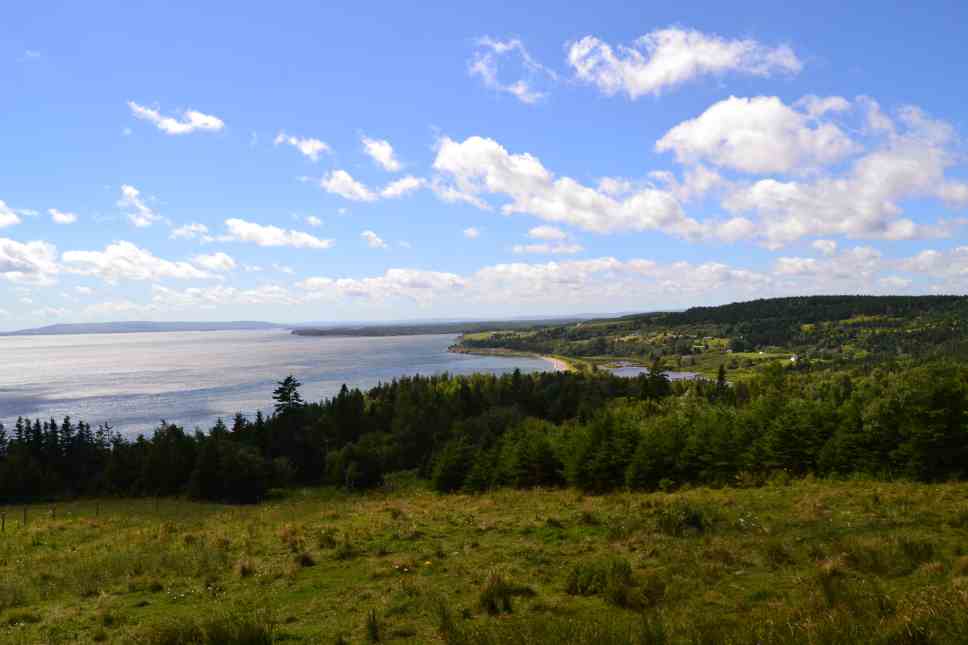

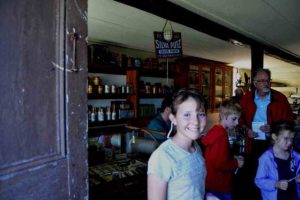

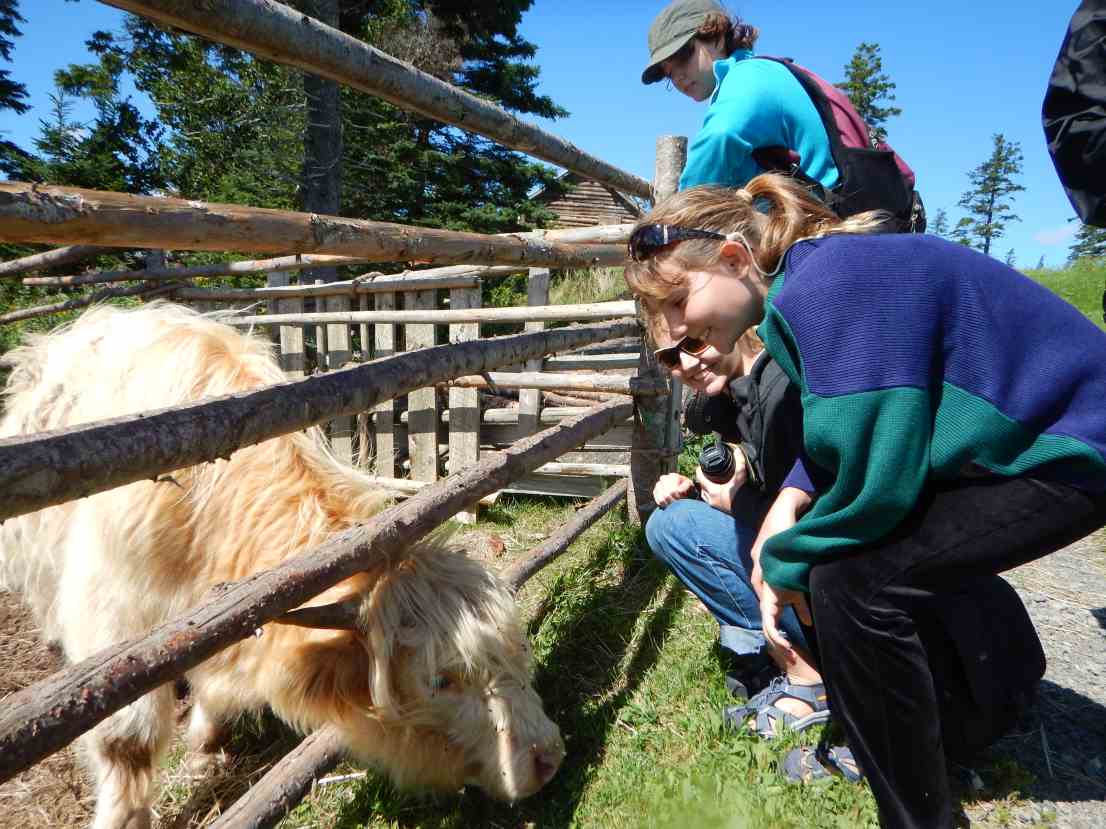
3 comments
Thank you for this most interesting blog entry Marike! As a Canadian (and one who lived in Nova Scotia for 2 years) you would assume that I would know all of this history. Well I didn’t. Now I do. Thank you!!! 🙂
Hello,
Dit lyk of julle nog in the amerika omgewing is. Dit is dalk moontlik dat John en ek julle erens kan ontmoet. Deesdae is dit nie so duur om vlieg kaartjies te koop nie. Waar beplan julle om volgende te land?
Voorspoedige Nuwe Jaar!